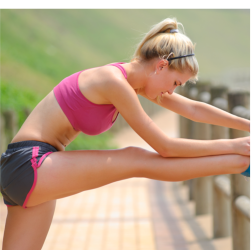Should You Choose Walking versus Running for Your Overall Health Benefits?
Both aerobic activities are simple to perform and promote weight loss. And both walking and running help regulate a healthy sleep rhythm, elevate your energy levels while awake, and even allow you to maintain healthy blood pressure and cholesterol levels.
Running and walking can also be social exercises that you enjoy with friends or family members, and you can take a jog or a hike just about any time of the year, depending on where you live.
Walking is Easier on Your Body Than Running
Just remember that if you choose walking over running to improve your overall health, you will need to walk twice as far as you run to gain the same weight-loss benefits. Running is much more rigorous on your body, and burns more calories. But walking is also much easier on your joints since the impact of your foot striking the ground is lessened.
For Beginners Walking is the Best Place to Start
If you are just beginning some type of dedicated physical regimen, walking is definitely recommended, and you can always build up your endurance and physical fitness to include running in the future.
And in some cases, walking can give you many of the same benefits as running, with less downside. For instance, extensive research taken from the Runners and Walkers Health Study shows that both running and walking equally cut down on your risk of contracting age-related cataracts.
That significant body of information, compiled from tens of thousands of runners and walkers, also showed that runners could expect a reduction in the risk of contracting heart disease by about 4.5% by running one hour a day.
Running Beats Walking for Weight Loss
But those who spent that same one hour daily simply walking cut their risk of heart disease by over 9%. Certainly, walking and running both improve your overall health and fitness much more than if you were sedentary instead. So choose whichever exercise best fits your current fitness levels and situation. And for weight loss, running is definitely the better vehicle than walking. That is because of the increased energy expenditure, elevated heart rate and calorie burn.
Before Walking or Running for Exercise – Check With Doctor First
You should always consult a doctor before adding any type of exercise to your daily routine. But both walking and running are excellent ways to get you up and active, and are low-cost activities which you can enjoy even if you only have a limited amount of time on your hands.
There is no argument that running or walking is much healthier than not doing either, so put one foot in front of the other today and begin to enjoy the heart and total body benefits are that these simple but healthy exercises can provide.
Avoiding Bulky Legs While On a Walking Fitness Program
Because muscles have two different types of fiber, some walking fitness programs target one type of fiber better than the other. To avoid bulking up your legs, you want to follow a walking fitness program that targets slow twitch fibers as they do not grow significantly from their current size.
If you choose a program that targets the fast twitch fibers, you stand more of a chance at building up leg muscle than you may not want as those fibers do have the capability to grow in size.
Follow These Five Steps to Keep From Building Up Bulky Legs:
- When planning your walking course, avoid hills, inclines or stairs. Moving your body vertically emphasizes building up the glutes, hamstrings and calves, which can give you a bulky appearance. Staying on flat land works all of your lower body muscle groups equally.
- Maintain a proper posture by engaging your abdominal muscles and keeping your head and neck centered over your spine. This keeps your weight evenly balanced vertically across your muscles supporting it, thus not working one group more than others.
- Don’t walk with added weight. While ankle and wrist weight do increase the number of calories you burn while walking, the additional weight on your ankles can make your large lower body muscle groups work harder thus developing them more.
- The same advice applies to other things you may carry with you. What you carry in your backpack can add additional weight, so think about what you really need and leave the rest at home.
- How you walk can make a difference. In a proper walk, your foot should land on the outside of your heel. As your step progresses forward, your weight should shift forward and inward to your arch. At the end of your step, your weight should shift to the ball of your foot and then to your toes where you push off for the next step. If you land on the middle part of your foot, you can strengthen and ultimately enlarge your calf muscles.
For Walking or Running Choose Good Shoes
Of course, having a good pair of walking shoes that fit well and support your arch will make walking properly much easier.
By selecting a walking fitness course that works slow twitch leg muscle fibers and following the rest of the above steps, you can safely burn calories and lose weight without having to worry about bulking up your leg muscles. As you lose weight, your toned and well defined leg muscles will begin to show themselves.
If you’d like to get more out of your walking for fitness plan, check out the “Guide to Setting Your Walking Fitness Goals” for more in depth knowledge on the subject of walking for fitness. While you’re there, be sure to sign up for the free MyFitnessNut.com Newsletter to be kept up to date on the latest health and fitness topics.
